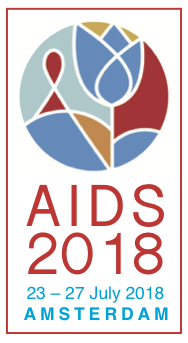Swifter viral load suppression with dolutegravir vs efavirenz in late pregnancy: results from DolPHIN-1
3 August 2018. Related: Conference reports, Pregnancy, World AIDS 22 Amsterdam 2018.
 Polly Clayden, HIV i-Base
Polly Clayden, HIV i-Base
A significantly greater proportion of women achieved undetectable viral load starting a dolutegravir (DTG)-based regimen late in pregnancy, compared with one based on efavirenz (EFV). [1] Median time to undetectable viral load with DTG was approximately half of that with EFV.
These findings from the DolPHIN-1 study, conducted in South Africa and Uganda, were shown at AIDS 2018.
Presenting author, Saye Khoo, from the University of Liverpool, explained that in South Africa around a fifth of HIV positive women start ART late in the third trimester. Late initiation is associated with a 7-fold increase in risk of vertical transmission and doubling of infant mortality in the first year of life.
DolPHIN-1 was a pilot study designed to look at whether DTG reduces vertical transmission at delivery and during breast feeding among women starting ART in the third trimester.
The study randomised 60 treatment naive pregnant women at 28–36 weeks’ gestation 1:1 to receive EFV (n=31) or DTG (n=29) plus tenofovir disoproxil fumarate (TDF) and either lamivudine (3TC; Uganda) or emtricitabine (FTC; South Africa) until two weeks postpartum. The primary endpoint was pharmacokinetics (PK) of DTG in women and breastfed infants; secondary endpoints included viral suppression.
In line with national guidelines, which state that women diagnosed in pregnancy start ART immediately, participants started EFV plus TDF/3TC or FTC while waiting for randomisation.
All participants randomised to DTG switched within 7 days.
At baseline participants were a median age of 26 years, with CD4 count of 394 cells/mm3 and viral load of 4.0 log copies/mL, across the two arms. Median gestation was 31 weeks, weight 66 kg and BMI 26. A high proportion (approximately 22%) of participants used traditional medicines.
Rich PK sampling was performed in the third trimester and postpartum. Third trimester DTG exposures were low with Ctrough at or below target (MEC 324 ng/mL) in 9/28 (32%) participants. All but one was above DTG protein adjusted IC 90 (64 ng/mL). Postpartum exposures were not significantly different to third trimester but Professor Khoo noted that the time of sampling (median 8 days) did not reflect return to normal physiology.
Maternal:cord blood ratio was 1.21 and breast milk:maternal plasma 0.03. After cessation, DTG was rapidly eliminated from breast milk; but infant washout was prolonged.
By ITT, a significantly greater proportion of participants in the DTG vs EFV arm achieved viral load <50 copies/mL at 2 weeks postpartum: 20 (69%) vs 12 (38.7%), p=0.02. Median time to < 50 copies/mL was approximately halved with DTG compared to EFV.
Safety of DTG and EFV was comparable but this evaluation is limited by the small sample size, short follow up and initial use of EFV in participants randomised to DTG-based ART.
comment
An earlier report from a scheduled interim analysis of DolPHIN-1, after the first 16 women delivered, emphasised that HIV positive women who start ART in late pregnancy are a vulnerable group with a higher risk of adverse outcomes and vertical transmission of HIV than those who start ART earlier. [2, 3]
DolPHIN-2 is ongoing and randomising 250 late presenting women 1:1 to either DTG- or EFV-based ART. The mothers and infants will be followed up from start of treatment until weaning of the infant or 18-months postpartum (whichever is earlier).
DolPHIN-2 is designed to generate high-quality evidence on the efficacy and safety of DTG to help inform recommendations, and operational guidance on use of DTG in this high-risk scenario.
It is important not to conflate the recent findings with preconception DTG exposure with starting it in pregnancy, particularly among late presenters, where the rapid viral suppression associated with DTG appears to have an advantage over current EFV-based standard of care.
Polly Clayden is on the trial steeringcommittees of DolPHIN 1 and 2.
References
- Orrell C et al. DolPHIN-1: randomised controlled trial of dolutegravir (DTG)- versus efavirenz (EFV)-based therapy in mothers initiating antiretroviral treatment in late pregnancy. AIDS 2018. Amsterdam. 23–27 July 2018. Oral abstract THAB0307LB.
http://programme.aids2018.org/Abstract/Abstract/13144 (abstract)
https://www.youtube.com/watch?v=djY2rjG_F-c (webcast) - Waitt C et al. DolPHIN-1: dolutegravir vs efavirenz when initiating treatment in late pregnancy. 25th CROI. Boston. 4–7 March 2018. Poster abstract 807.
http://www.croiconference.org/sessions/dolphin-1-dolutegravir-vs-efavirenz-when-initiating-treatment-late-pregnancy (abstract and poster) - DolPHIN2 website.
https://www.dolphin2.org

